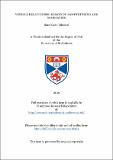Files in this item
Vehicle relationism : essays on samethinking and samesaying
Item metadata
| dc.contributor.advisor | Ball, Derek Nelson | |
| dc.contributor.advisor | Cappelen, Herman | |
| dc.contributor.author | Vikesdal, Sara Kasin | |
| dc.coverage.spatial | [4], 196 p. | en_US |
| dc.date.accessioned | 2019-09-26T10:22:13Z | |
| dc.date.available | 2019-09-26T10:22:13Z | |
| dc.date.issued | 2019-12-04 | |
| dc.identifier.uri | https://hdl.handle.net/10023/18564 | |
| dc.description.abstract | This thesis is about the nature of samethinking and samesaying. These notions are broad and capture various distinct but related phenomena. I will focus on two particular understandings of ‘samethinking’, and on one particular understanding of ‘samesaying’. Let me address samethinking first. On the first understanding of ‘samethinking’, samethinking occurs whenever two thoughts concern the same referent. We may distinguish between two different ways in which this can occur. First, there are cases in which the sameness of reference is manifest to the subject. Take for instance the two beliefs BOB DYLAN IS A MUSICIAN and BOB DYLAN WON A NOBEL PRIZE. In such cases, the sameness of reference is transparent to the thinker in such a way that she may combine the two beliefs in an inference and conclude directly from these two beliefs alone that a musician won a Nobel Prize. Second, there are cases in which two thoughts concern the same referent, but where the sameness of reference is not manifest to the subject. Take for instance the two thoughts BOB DYLAN IS A MUSICIAN and ROBERT ZIMMERMAN WON A NOBEL PRIZE. ‘Robert Zimmerman’ is Bob Dylan’s birth name, so the two thoughts concern the same individual. However, unless the thinker has a further belief to the effect that Bob Dylan is Robert Zimmerman, she may not rationally infer from these beliefs that a musician won a Nobel Prize. We see, then, that two pairs of thoughts that are referentially equivalent may nonetheless play different roles in cognition. In this thesis, I offer a novel account of how to understand the difference between cases of samethinking such as those above. The second understanding of ‘samethinking’ that I will discuss in this thesis is a broader phenomenon. Two thoughts, typically entertained by distinct individuals or the same individual at different times, can be said to concern the same subject matter despite differing in their overall semantic properties. Likewise, it seems that two utterances may concern the same topic despite differing in their overall semantic properties. Consider for instance someone uttering the sentence “Whales are fish” in the 18th century, where such an utterance would generally be regarded as true. If someone today were to utter the same sentence, however, we would regard it as false. We have reason to think that the meaning of the term ‘fish’ has changed between then and now. Even if this is the case, it seems as though the 18th-century person and the current day individual are, in an interesting way, talking about the same topic when uttering the sentence. This is the notion of ‘samesaying’ I will address in this thesis. I shed light on what it is for two thoughts or two utterances to be the same in this way. | en_US |
| dc.language.iso | en | en_US |
| dc.publisher | University of St Andrews | |
| dc.title | Vehicle relationism : essays on samethinking and samesaying | en_US |
| dc.type | Thesis | en_US |
| dc.type.qualificationlevel | Doctoral | en_US |
| dc.type.qualificationname | PhD Doctor of Philosophy | en_US |
| dc.publisher.institution | The University of St Andrews | en_US |
| dc.identifier.doi | https://doi.org/10.17630/10023-18564 |
This item appears in the following Collection(s)
Items in the St Andrews Research Repository are protected by copyright, with all rights reserved, unless otherwise indicated.

